General Fusion
Today I’ll talk about one alternative project for creating a controlled thermonuclear fusion reactor, which I personally like for its absolute engineering dissimilarity to anything. We are talking about the Canadian startup General Fusion , which has existed for more than 10 years and has raised around $ 100 million for its development over this time.

Co-founders of the company Doug Richardson (left) and Michel Laberge (right) against the background of a plasma injector for his car.
Now listen to what idea you can collect so much money. In the GF spherical reactor, hundreds of powerful steam hammers placed around the perimeter will synchronously hit a rotating three-meter “drop” of molten lead to form a converging spherical wave. In the center of the droplet, there remains a vertical channel into which plasma vortices from the deuterium-tritium mixture are injected. The precisely calculated operation of the system will lead to compression exactly in the center of the plasma formation by the liquid metal wall and a thermonuclear reaction will occur, during which the explosion equivalent of several hundred kilograms of TNT will be released.
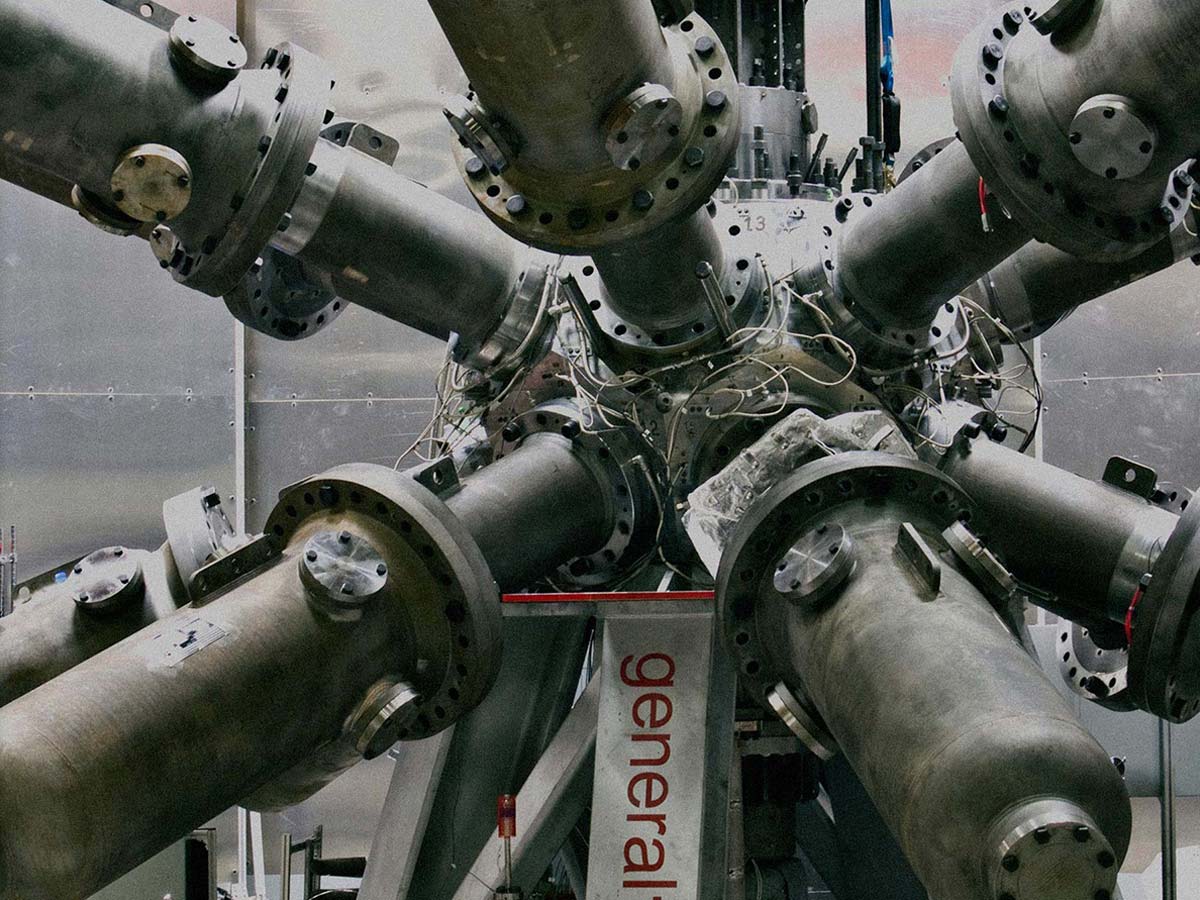
An experimental sphere with 14 steam hammers, on which the principle of the formation of a converging shock wave was tested.
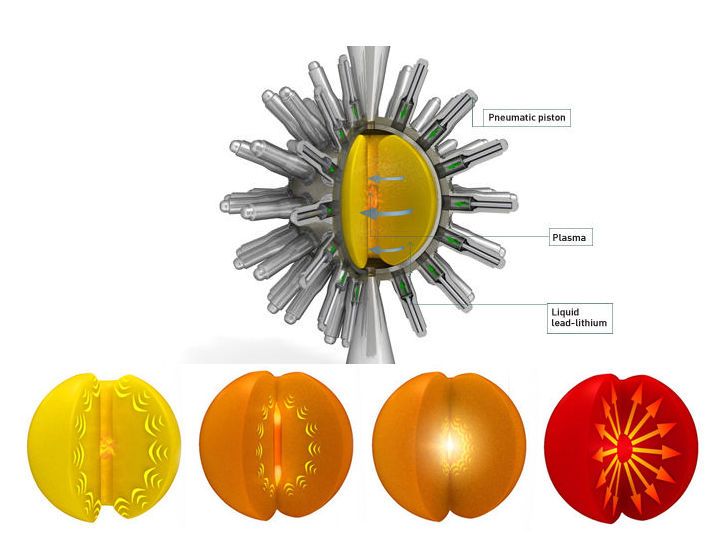
The design image of the power reactor on this principle and the sequence of its operation.
The collapsing liquid metal shell around the plasma vortices was considered as a driver of the thermonuclear reaction back in the 70s, in the LINUS conceptual installation. However, the 70s ... 80s - it was the time of the upcoming victory of the tokamaks, the first installations that reached the manifestation of thermonuclear reactions. Hands did not reach LINUS.

The original LINUS concept, 1979
But in the 90s, when disappointment began with tokamaks, and magnetic traps in general, two alternative branches of thermonuclear installations based on inertial synthesis (“laser thermonuclear”) and the lesser known idea of compressing magnetized plasma (to this direction, for example this group of projects, including the well-knownMagLIF , various pinch-installations, etc.) are being developed. At the same time, if inertial synthesis quickly gets the support of the military, (i.e., the conditions in the target are close to those of thermonuclear weapons), then the compression of magnetized plasma (FFP further) becomes a mecca for startups. The most famous of them are Tri Alpha Energy, Helion Energy and perhaps General Fusion.
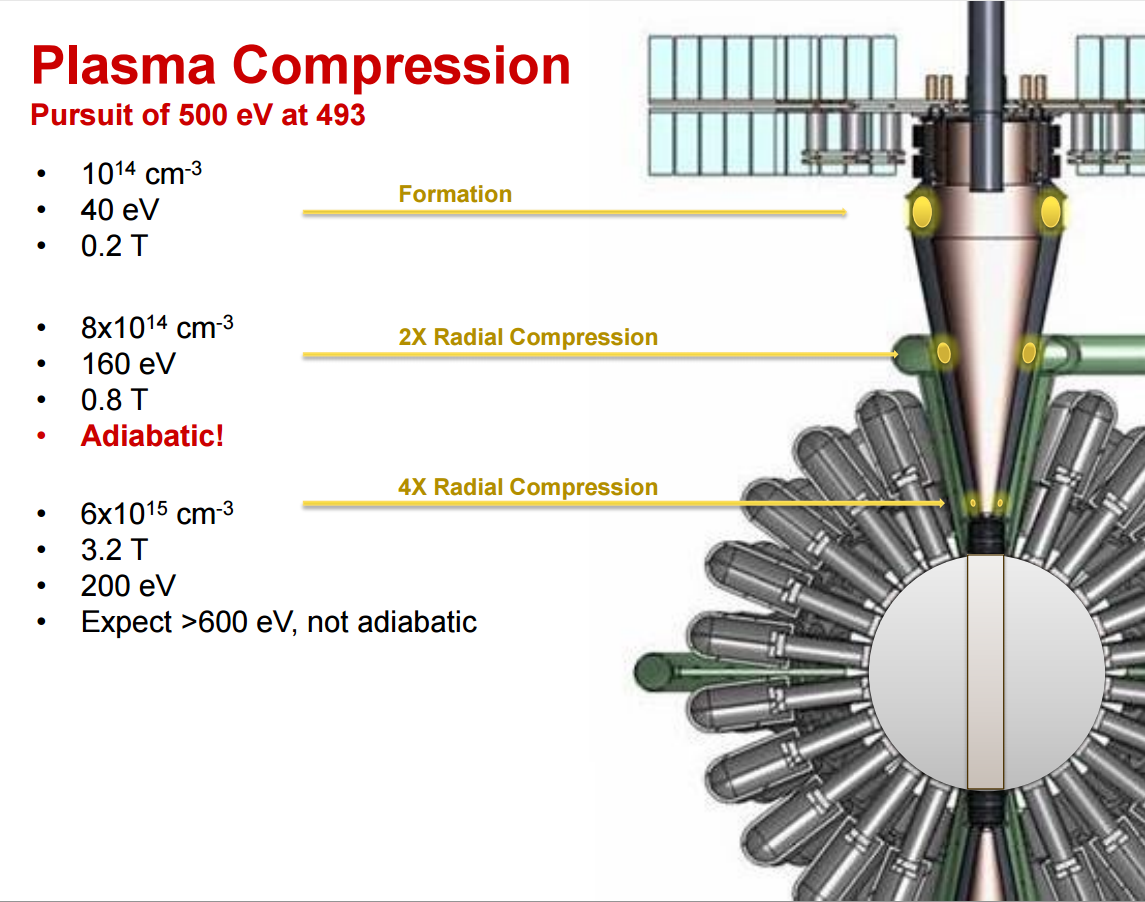
Work of a plasma injector. It can be seen that even before the final compression with liquid metal, the plasma is compressed several times, raising the temperature to 2 million degrees and the density to 0.06% of the required for a thermonuclear reaction.
The General Fusion installation is planned as a pulse - one thermonuclear microexplosion every 2 seconds. A big advantage compared to other pulsed installations is the absence of consumable elements (holraums, liners, cartridges, etc.) - only plasma and a lead drop are needed. Each explosion will produce 720 megajoules of heat, which will be absorbed by the liquid metal and transferred to the steam generator through a heat exchanger.
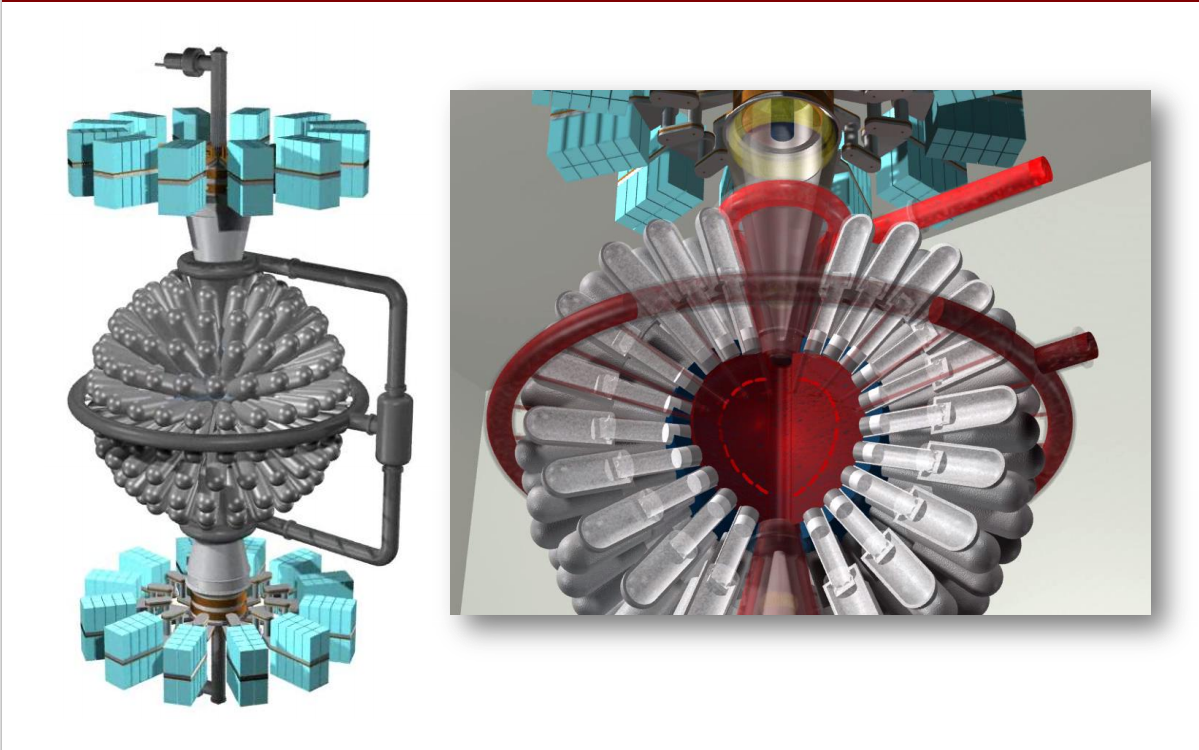
Design image of a power reactor. Blue elements - high voltage power of plasma injectors.
Part of the steam will work as a steam hammer driver, and part will generate 65 megawatts of electricity on a turbogenerator. Of course, in this setup, we will also need a rather sophisticated system for high-voltage feeding of plasma dischargers, purification of lead, and propagation of tritium (GF believe that this can be done by mixing lithium into liquid lead. By absorbing thermonuclear neutrons it will fall apart into helium and tritium), but first of all this still needs to survive. In general, if the key point - thermonuclear ignition - is realized, compared to other concepts of fusion reactors, this will be a breakthrough in terms of simplicity and cheapness.

The current GF installation with a liquid metal loop, on which in 2013 obtained spherical implosions of the desired quality.
However, the key problem in all this direction, and the GF machine in particular, is the development of instabilities that do not allow energy to be concentrated to the desired values, but scatter it around uselessly. Any asymmetries and inaccuracies in the compression will lead to the fact that a positive output of energy from this Steampunk monster will not work. This problem in various forms at the moment has successfully buried more than a dozen concepts. Nevertheless, the brainchild of Michael Laberger went through many tests at the early, model stages, with open discussions by the scientific community of the results. It is this approach that has attracted many serious investors (including Amazon.com founder Jeff Bezos).
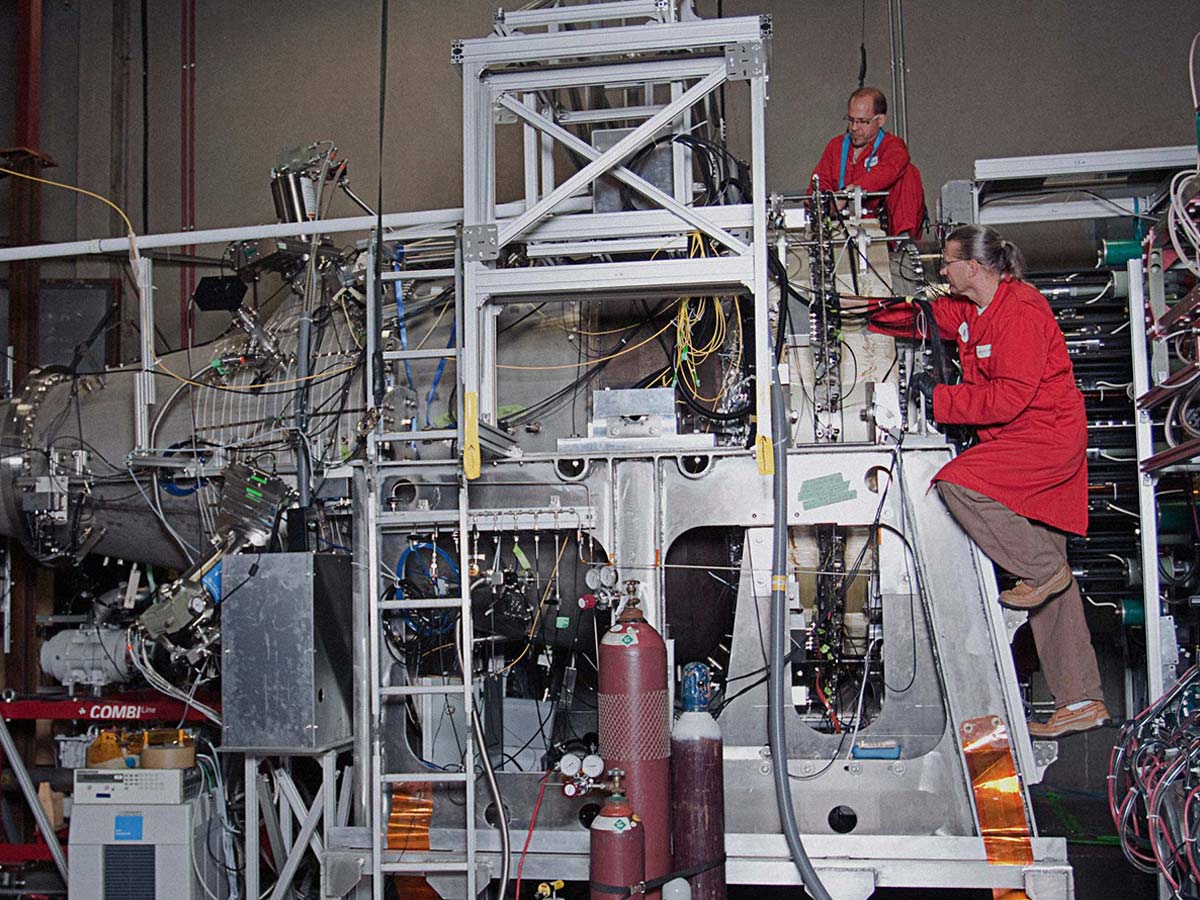
Set up a plasma injector for tests.
So far, GF is full of optimism, although despite the successful creation of full-size prototypes of all elements of the machine (steam hammers, spheres with liquid lead, arresters - plasma vortex generators) and even the machine itself for two years they have not shown any results, which most likely indicates that, like dozens of other concepts in this field, GF encountered great difficulties in the way of energy concentration.

Co-founders of the company Doug Richardson (left) and Michel Laberge (right) against the background of a plasma injector for his car.
Now listen to what idea you can collect so much money. In the GF spherical reactor, hundreds of powerful steam hammers placed around the perimeter will synchronously hit a rotating three-meter “drop” of molten lead to form a converging spherical wave. In the center of the droplet, there remains a vertical channel into which plasma vortices from the deuterium-tritium mixture are injected. The precisely calculated operation of the system will lead to compression exactly in the center of the plasma formation by the liquid metal wall and a thermonuclear reaction will occur, during which the explosion equivalent of several hundred kilograms of TNT will be released.

An experimental sphere with 14 steam hammers, on which the principle of the formation of a converging shock wave was tested.

The design image of the power reactor on this principle and the sequence of its operation.
The collapsing liquid metal shell around the plasma vortices was considered as a driver of the thermonuclear reaction back in the 70s, in the LINUS conceptual installation. However, the 70s ... 80s - it was the time of the upcoming victory of the tokamaks, the first installations that reached the manifestation of thermonuclear reactions. Hands did not reach LINUS.

The original LINUS concept, 1979
But in the 90s, when disappointment began with tokamaks, and magnetic traps in general, two alternative branches of thermonuclear installations based on inertial synthesis (“laser thermonuclear”) and the lesser known idea of compressing magnetized plasma (to this direction, for example this group of projects, including the well-knownMagLIF , various pinch-installations, etc.) are being developed. At the same time, if inertial synthesis quickly gets the support of the military, (i.e., the conditions in the target are close to those of thermonuclear weapons), then the compression of magnetized plasma (FFP further) becomes a mecca for startups. The most famous of them are Tri Alpha Energy, Helion Energy and perhaps General Fusion.

Work of a plasma injector. It can be seen that even before the final compression with liquid metal, the plasma is compressed several times, raising the temperature to 2 million degrees and the density to 0.06% of the required for a thermonuclear reaction.
The General Fusion installation is planned as a pulse - one thermonuclear microexplosion every 2 seconds. A big advantage compared to other pulsed installations is the absence of consumable elements (holraums, liners, cartridges, etc.) - only plasma and a lead drop are needed. Each explosion will produce 720 megajoules of heat, which will be absorbed by the liquid metal and transferred to the steam generator through a heat exchanger.

Design image of a power reactor. Blue elements - high voltage power of plasma injectors.
Part of the steam will work as a steam hammer driver, and part will generate 65 megawatts of electricity on a turbogenerator. Of course, in this setup, we will also need a rather sophisticated system for high-voltage feeding of plasma dischargers, purification of lead, and propagation of tritium (GF believe that this can be done by mixing lithium into liquid lead. By absorbing thermonuclear neutrons it will fall apart into helium and tritium), but first of all this still needs to survive. In general, if the key point - thermonuclear ignition - is realized, compared to other concepts of fusion reactors, this will be a breakthrough in terms of simplicity and cheapness.

The current GF installation with a liquid metal loop, on which in 2013 obtained spherical implosions of the desired quality.
However, the key problem in all this direction, and the GF machine in particular, is the development of instabilities that do not allow energy to be concentrated to the desired values, but scatter it around uselessly. Any asymmetries and inaccuracies in the compression will lead to the fact that a positive output of energy from this Steampunk monster will not work. This problem in various forms at the moment has successfully buried more than a dozen concepts. Nevertheless, the brainchild of Michael Laberger went through many tests at the early, model stages, with open discussions by the scientific community of the results. It is this approach that has attracted many serious investors (including Amazon.com founder Jeff Bezos).

Set up a plasma injector for tests.
So far, GF is full of optimism, although despite the successful creation of full-size prototypes of all elements of the machine (steam hammers, spheres with liquid lead, arresters - plasma vortex generators) and even the machine itself for two years they have not shown any results, which most likely indicates that, like dozens of other concepts in this field, GF encountered great difficulties in the way of energy concentration.
